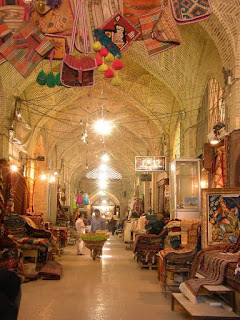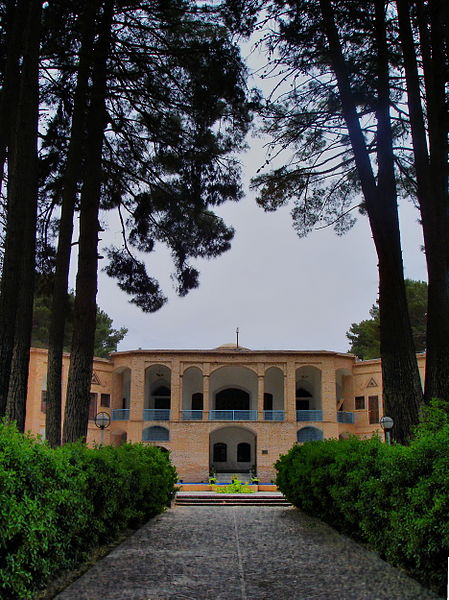Vakil Bazaar
The wonderfully photogenic
Vakil Bazaar is
Shiraz’s main market place and home to hundreds of shops and stalls. Satisfyingly labyrinthine, the bazaar is the place for buying rugs, spices, jewellery, and household goods. Stumbling across teahouses, courtyards, caravanserais, and the traditional bathhouse, you may need more than one afternoon to explore the entirety of the
Vakil Bazaar. The vaulted arched ceilings are a fine example of 18th century Zand architecture, and make for a pleasantly cool atmosphere through which to meander.
Eram Garden
Eram Garden (Bagh-e Eram), located along the northern shore of the Khoshk River in
Shiraz, is one of the most famous and beautiful Persian gardens in all of Iran. It should be noted that the word ‘Eram’ is the Persian version of the Arabic word ‘Iram’ which means heaven in Islam’s most holiest of books, the Qur’an. With its beautiful grounds, lush plant life and aesthetic attractions, it’s easy to see why Eram evokes such a description.
Shah-e Cheragh Mausoleum
The most important pilgrimage centre of the city of
Shiraz is the Mausoleum of Mir Sayyed Ahmad, the son of the seventh Emam known as Shah-e-Cheragh (the Shrine of the lord of the light), which is situated near the Masjed-e-No. Mir Sayyed Ahmad came to Shiraz at the beginning of the third Islamic century, and died there. After the shrines of Imam Reza in Mashhad and Fatima in Qum, the third most venerated pilgrimage destination in Iran is the shrine of Shah Cheragh in the city of Shiraz.
Nasir ol-Mulk Mosque
The
Nasir-ol-Molk Mosque also known as the Pink Mosque, is a traditional mosque in Shiraz, Iran. It is located at the district of Gowad-e-Araban, near Shah Cheragh Mosque.
The mosque includes extensive colored glass in its facade, and displays other traditional elements such as the Panj Kase ("five concaved") design. It is named in popular culture as the Pink Mosque, due to the usage of considerable pink color tiles for its interior design.
Tomb of Hafez
Hafez is arguably the most loved and respected poet in the vast canon of Persian literature. Considered the master of the ghazal (a short, amorous, rhyming poem), Iranians from all walks of life can quote his verses on demand. His tomb resides in a well-kept garden in northeast Shiraz; more than a tourist attraction, it functions as a site of pilgrimage for his admirers the world over. Have your fortune told, visit the onsite teahouse, and contemplate the playful nuances of his lyrical ingenuity as you wander around the extensive grounds.
Tomb of Sa’di
The 13th century poet Sa’di was an important precursor to
Hafez, and is one of the most cherished ancestors of modern day Shirazis. Many of his pithy maxims have attained a proverbial status, and he is widely praised for the enduring simplicity of his verse. His tomb is less busy than that of Hafez, but is located nearby and worth visiting on the same day. The underground teahouse offers a cool spot to refresh yourself after exploring the garden of roses and cypress trees.
Persepolis
Persepolis, or Takht-e Jamshid in Persian, was the magnificent ceremonial capital of the ancient Achaemenid Empire, over 2500 years ago. Ransacked by Alexander the Great, the site represents the pinnacle of ancient Iran’s political and architectural achievements. The UNESCO world heritage site is located about 70 kilometers northeast of Shiraz, and tours will take you from the city center on a day trip. The impressive ruins require a good few hours to explore, although take plenty of water, for the midday sun can be pretty unforgiving.
Naqsh-e Rostam and Naqsh-e Rajab
A tour to Persepolis should include a visit to the nearby rock tombs and reliefs of Naqsh-e Rostam and Naqsh-e Rajab. The former consists of four massive tombs built into the face of a cliff, an appropriately ostentatious final resting place for four Achaemenid kings. Below you will see some stone reliefs depicting various Sassanian imperial triumphs, such as the Roman Emperor Valyerian kneeling before Shapur I. Four more Sassanian reliefs can be found at the less well-tended Naqsh-e Rajab, only five minutes away.
Pasargadae
Pasargadae was the first dynastic capital of the Achaemenid Empire, founded by Cyrus II the Great, in Pars, homeland of the Persians, in the 6th century BC. Its palaces, gardens and the mausoleum of Cyrus are outstanding examples of the first phase of royal Achaemenid art and architecture and exceptional testimonies of Persian civilization. Particularly noteworthy vestiges in the 160-ha site include: the Mausoleum of Cyrus II; Tall-e Takht, a fortified terrace; and a royal ensemble of gatehouse, audience hall, residential palace and gardens.
Pasargadae was the capital of the first great multicultural empire in Western Asia. Spanning the Eastern Mediterranean and Egypt to the Hindus River, it is considered to be the first empire that respected the cultural diversity of its different peoples. This was reflected in Achaemenid architecture, a synthetic representation of different cultures.














Comments
Post a Comment